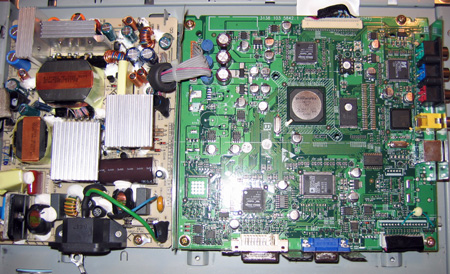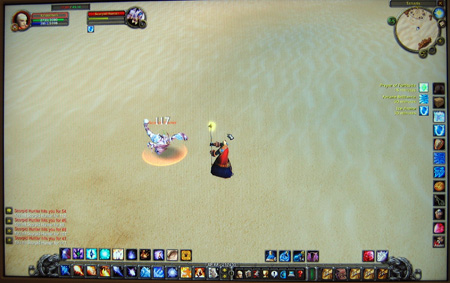
Original Link: https://www.anandtech.com/show/1729
HP L2335: Low Response Time and High Resolution LCD
by Kristopher Kubicki on July 8, 2005 7:00 AM EST- Posted in
- Displays
Introduction
It was only 18 months ago when we took a look at Samsung's SyncMaster 213T and declared it the best $1,000 LCD that we had seen. The (relatively) high resolution of 1600x1200, the bright backlight and sleek look put the 213T in the "Ultra-Enthusiast" pool with very few competitors. Ultra-High End has a whole new meaning now, and with reason. Since the Samsung 213T, we have seen high end displays shift toward wide screen, and support for higher resolutions and smaller pixel pitches (0.258mm versus 0.27mm). The entire industry owes Dell a slight pat on the back for their part in really pushing the price barrier.We were a little surprised when Dell unveiled their next generation lineup last year, since it did not include a 23" display based on a SIPS panel. Instead, two of Dell's four displays went to Samsung (the UltraSharp 1905FP and the 2405FPW) and the mainstream model went to LG.Philips (the UltraSharp 2005FPW). Although the UltraSharp 1905FP and 2005FPW turned out to be phenomenal monitors and the 2405FPW is the cheapest LCD larger than 21", did Dell make the right move by ditching LG.Philips for the highest model? Apple and HP certainly think that LG.Philips LCD has the right formula with their Super IPS displays, and in past display reviews, 8-bit SIPS displays have done very well in our comparisons.
Today, we are taking a look at a display that has been available for a little while, but it's only been a few weeks since it broke the magic $1,000 barrier. The HP L2335 is actually a business display - but it just so happens to support component, composite, S-Video, signal zoom and a 16ms gray-to-gray response time. While I love working in Excel on a 23" LCD as much as the next guy, playing World of Warcraft at 1920x1200 on a low response time display doesn't get any better. Obviously, the market has changed quite a bit in 18 months. What was once top of the line barely gets recognition here on AnandTech, and the monitors that do end up on top are truly modern marvels. Does HP have the opportunity to pick up where Dell left off and capitalize on the success of previous LG.Philips panels? That's exactly what we are set to find out!
Specifications
The HP L2335 is advertised as a business 23" display. We certainly have no problem using the L2335 for business, but in our opinion, this may be the ultimate gaming monitor under $1000. Like other Super IPS displays, the HP L2335 features a 0.258mm pixel pitch, 16ms response time and a relatively conservative contrast ratio and brightness. This is a true 8-bit LCD and our benchmarks should reflect that later on in the benchmarks of this review - almost a necessity in our book.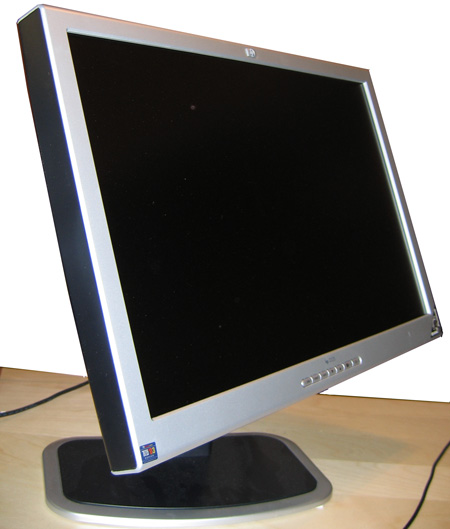
| Hewlett Packard 23" L2335 | |
| LCD Panel | 23" WUXGA LCD (Active Matrix) pixel pitch: 0.258mm Anti-glare coating Super IPS Panel |
| Advertised Scanning Frequency | Horizontal: 30-94kHz Vertical: 48-85Hz |
| Advertised Response Time | 16ms (Typical) |
| Advertised Viewing Angle | 170 / 170 (Horizontal / Vertical) |
| Advertised Contrast Ratio | 500:1 (Typical) |
| Advertised Compatibility | 1920 x 1200 (Native) |
| Advertised Brightness | 250 cd/m2 |
| Advertised Warranty | 3 years parts, labor and on-site |
Almost everything about this display is identical to the Dell 2005FPW except size and resolution. Viewing angle, response time and contrast ratio are all identical - a common trait, since both displays use panels from the same LG.Philips LCD family. The L2335 also features component, composite and S-Video inputs, a pivotable panel and Picture In Picture, features that we saw on the Dell 2005FPW lineup too.
It seems odd that we would pat a company on the back for advertising their product specifications to be the same as the OEM, but it feels so good to not see a company flat out lying about their specifications. If anything, HP may have been a little conservative in their specifications of the display, as the 170/170 viewing angle is slightly below what the panel manufacturer advertises (but we will get more to that in a minute). Consider HP's only real competitor in the 23" segment is Apple, and in the whole Ultra-Enthusiast market, they only really need to look out for Dell. Given Dell's move to tone down some of their "marketecture", it looks like the whole industry may be moving away from exaggerating their specifications. After all, LCDs are running out of room to innovate.
Even though the HP website claims that the L2335 display uses less than 100W during operation, the actual number that we recorded with a Kill-A-Watt device in the lab was 73W during operation, and 4W in sleep mode. Compare this to displays like the Dell 2005FPW that uses 53W during normal operation.
Cable Management, Pivot, Stand
The HP L2335 doesn't win any awards for looks when it isn't turned on. The depth of the LCD leaves something to be desired and the drab silver bezel reminds us of a circa 1998 HP desktop. Form follows function when it comes to computer components (unless you're Apple), and even though the monitor isn't the most attractive thing that we've seen, it still has enormous potential in performance.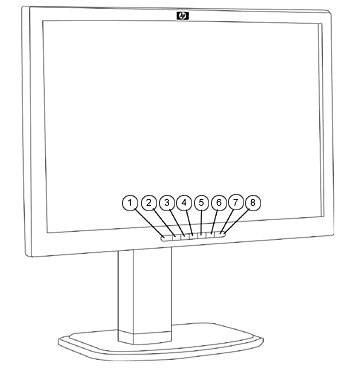
All of the component, composite and s-video connectors plug in via a hatch on the side. HP would have scored some bonus points by including Firewire or USB inputs on the display, but we won't hold them against it.
Our only real surprise in this review came when attempting to pivot the display. Unlike Dell, Samsung, LG, Sony and virtually any other display manufacturer that makes a pivoting display, pivoting the L2335 is a counter-clockwise operation. It actually took us a few minutes to catch on this small detail. Furthermore, the 23" screen is very large; it takes a bit of muscle to rotate and tilt this display. Almost to add insult to injury, there is no clearance to pivot this monitor when the stand is at its lowest height, so that too must be adjusted in order to pivot the display. Portrait mode was an interesting concept when LCD displays could only do 1280x1024 resolutions, but pivoting the L2335 makes almost no sense to us; there just aren't that many applications where you would need 1920 vertical pixels. Personally, opening two 900x1200 terminals side by side for paging is a more elegant and practical solution.
Like virtually every LCD that we've seen in the last 5 years, the HP L2335 panel is removable in the event that you'd want to replace it with a VESA compatible arm or wall mount.
Internals
After benchmarking both monitors, we opened them up to get a more in-depth look at the individual apparatuses. As a general disclaimer, we suggest that you do not open your displays as you will certainly void the warranty and probably destroy the panel.Like in most big displays (with the exception of the Apple Cinema displays), the inverter is housed inside the display. You can see it below on the left side of the image. You'll notice a Silicon Image chipset controlling the DVI interface and another one for the TMDS controller (near the top). The L2335 also features a PixelWorks PW172 digital signal processor; a chipset found almost exclusively in this LCD. PixelWorks did a good job emulating almost all of the exact same features found on the Genesis gm1601, but there is no split screen capability.
![]()
LG.Philips LCD LM230W02
LG.Philips recently redesigned their website, and it's worth exploring around for a few minutes if you have some time. The LG.Philips LCD LM230W02 is something that we have mentioned a few times already in the review; no surprise, given the company's track record.The largest difference between the LM230W02 panel and a panel that we have looked at in the past (like the LM201W01 featured in the Dell 2005FPW) is the move from Low Voltage Differential Signaling (LVDS) to Transition Minimized Differential Signaling (a Silicon Image technology). Like the LM201W01, this panel boasts a 7ms Tr and 9ms Tf response time and 12ms gray-to-gray transient average times. Here is another interesting PDF documenting some of the really low level features of the display. Page 18 is probably the most useful page, documenting the specific gray-to-gray response times for various hues.
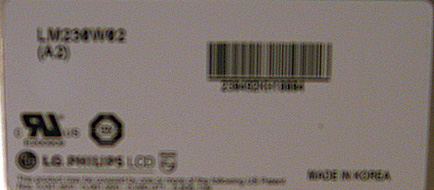
User Interface
Dell and Samsung might still dominate the user interface aspect of displays, but they don't dominate the entire feature set if HP has anything to say about it. The L2335 features a seven-button user interface that might be a little awkward than offerings from Dell and Samsung (and even LG), but HP didn't short-change the consumer on features by any means.
One of the features of Dell's menu is the ability to change the signal zoom, also called the video Scaling. Dell allows us to change from 1:1, Filled or Aspect scaling. HP does the exact same thing as demonstrated below. If you are really an avid gamer who must play Doom 3 without scaling interpolation at 800x600, the HP can display the signal in the center of the screen on an 800x600 pixel palette. A large complaint of mine is that my set top DVD player often doesn't zoom correctly for certain VCDs onto an HDTV. If you are playing a game or DVD that has butchered your aspect ratio, scaling the image to fill the screen may offer some compensation.

Quantitative Analysis
For the duration of this review, we connected the HP L2335 to a Radeon X800 Pro with factory default settings on the DVI connections unless stated otherwise. Brightness has been set to maximum as well.Luminance
Brightness ranked as one of our most important display qualities. On a display like the L2335, a dim image can make for a very poor viewing experience, since the resolution is so high. Fortunately, large displays are usually compensated for this with the addition of larger and brighter backlights. Too much compensation will result in an overly bright image, to which black levels and contrast ratios will suffer. Below, you can see a comparison of the brightness for each of our LCD monitors.
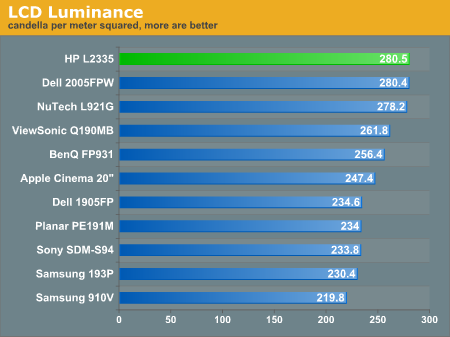
Our Contrast Ratio
We will use the same observation from the 19" LCD Roundup several months ago. Using PreCal and our ColorVision Spyder, we will measure the luminance of a pure white image and a pure black image on the LCD monitor. The observed contrast ratio is simply the highest recorded luminance divided by the lowest. All measurements are in candela per meter squared; larger contrast ratios are more desirable.| Observed Contrast Ratio | |||
| Highest Recorded (white image) | Lowest Recorded (black image) | Observed Contrast Ratio | |
| Apple Cinema 20" | 247.4 | 2.4 | 103.1 |
| BenQ FP931 | 256.4 | 3.6 | 71.2 |
| Dell 1905FP | 234.6 | 2.6 | 90.2 |
| Dell 2005FPW | 280.4 | 2.6 | 107.8 |
| HP L2335 | 280.5 | 2.6 | 107.8 |
| NuTech L921G | 278.2 | 2.6 | 107.0 |
| Planar PE191M | 234.0 | 3.0 | 78.0 |
| Samsung 193P | 230.4 | 2.2 | 104.7 |
| Samsung 910V | 219.8 | 2.6 | 84.5 |
| Sony SDM S94 | 233.8 | 3.0 | 77.9 |
| ViewSonic Q190MB | 261.8 | 2.6 | 100.7 |
Again, there is no surprise here where the HP performed the same as the Apple Cinema Display and the Dell 2005FPW. Since all three use LG.Philips LCD panels within the same generation, we had expected this. Again, note that the accuracy of our ColorVision Spyder is within 0.2 cd/m2 only, and this plagues the accuracy of our results. Our numbers should give you a good estimation of where each display falls in line with another, but it is far from an absolute authority.
Application Analysis
The core of our LCD benchmarking comes from real application analysis. We play with a lot of monitors and it gets easier for us each time to pick out problems with an LCD just by using the right application. Here are a few quick looks at some demanding full screen applications. We already ran ColorVision's OptiCal software, so all of our monitors are calibrated and adjusted to the same curves.High Definition Video - We played the WMV9 1080p and 720p versions of "Under Sea Adventure" to give our monitor a little taste of high definition video. Our other HD video playback has been done unscaled, but cropped in order to view the HD image quality in all its glory. With the last batch of LG.Philips LCDs, we were able to view WMV9 at 720p unscaled (because the monitors supported 1680x1050 resolutions), but this is really the first time that we will see 1080p unscaled. Like all other displays that we have seen to date, the L2335 does not support DVI-HDCP, so don't plan on watching video from your receiver on DVI just yet. Component connectors do work fine for this, however. Image quality was outstanding. Even though we have black bars across the bottom and sides, the image is still unscaled and takes up enough of the screen to really give an awesome experience.
The Matrix Reload, The Matrix - This dated, but useful, benchmark still gives us the ability to test FMV on the display. With such a large resolution, watching 480p unscaled is not particularly viewable, since it takes up such a small portion of the screen. Using the signal zoom in the display actually yields pretty decent results, although the screen was almost identical to playing the movie in full screen mode from the software DVD player. We could not detect a washed out look in any of the scenes that we checked during our analysis; all seems well in Matrix-land.

Max Payne 2 - The extreme light and dark transitions in Max Payne still provide us with the sufficient criteria to benchmark transient response time; specifically, we can focus on the light and dark extremes. Like the last few displays, we again had no problems with the color curves and no problems with the black and white transitions. There were periods in the game where we noticed the response time playing catch up, but as far as LCDs go, this was one of the better experiences that we've had.
Photoshop CS - Again, nothing but praise for this monitor. Once we had the image profile loaded, the HP L2335 was actually very pleasant to work on because we could work within an entire 1200x1200 or 1600x1200 image that was wholely contained in the display - without scaling. Even if you are not totally convinced that LCDs have the ability to replace CRTs for high quality image manipulation, at least the resolution is high enough to rival CRTs.
Subjective Analysis
For this portion of the benchmark, we will pit the HP L2335 display against monitors that we have looked at recently in the same size category. This is a subjective test that relies on our overall experience with the monitor after several hours of casual and thorough use. We also use test patterns and guidelines from the VESA FPDM 2.0 to rate each unit as fairly as possible.Here is generally how we rate a category:
5 - Outstanding; we have not seen anything to date that could rival our impression of this monitor's performance.
4 - Good, but room for improvement. There are units on the market that perform better.
3 - Average; this monitor performs well enough to maintain the status quo, but does not excel.
2 - Improvement needed; this monitor performs poorly in performance of this category.
1 - Unacceptable; this product does not pass even basic performance requirements.
| DisplayMate / CheckScreen / VESA FPDM 2.0 | |||||
| HP L2335 | Dell 2001FP | Dell 2005FPW | Apple Cinema 20" | Samsung 213T | |
| Intensity Range Check | 5 | 5 | 5 | 4.5 | 5 |
| Black Level Adjustment | 4.5 | 4.5 | 4.5 | 4.5 | 5 |
| Wide Angle Viewing | 4.5 | 3 | 5 | 5 | 5 |
| Defocusing, Blooming, Halos | 5 | 5 | 5 | 5 | 5 |
| Screen Uniformity and Color Purity | 5 | 4.5 | 5 | 5 | 4 |
| Dark Screen Glare Test | 4.5 | 4.5 | 4.5 | 4.5 | 4.5 |
| Primary Colors | 4.5 | 4 | 4.5 | 4.5 | 4.5 |
| Color Scales | 4.5 | 4 | 4 | 4.5 | 3.5 |
| 16 Color Intensity Levels | 4 | 4.5 | 4 | 4.5 | 4.5 |
| Screen Regulation | 5 | 5 | 5 | 5 | 5 |
| Streaking, Ghosting* | 5 | 5 | 5 | 5 | 5 |
| Motion Blur, Black + White | 4 | 3.5 | 4 | 4 | - |
| Motion Blur, Gaming | 4 | 3 | 4 | 4 | - |
*Note: the streaking/ghosting mentioned in this portion of the analysis refers to streaking and ghosting as interference, not as a byproduct of poor response time.
Notes from the Lab
Even though the HP L2335 scored very well in this analysis, there is some room for improvement. The market has progressed so much since the unveiling of the Samsung 213T that outstanding intensity range in early 2004 is just accepted as the standard today in 2005. We just looked at the Dell 2005FPW and the Apple Cinema display, so those benchmarks are the most relevant of the bunch in our analysis. Even thought the differences are getting more subtle from display to display, there are a few obvious points that we can make. When we had the Samsung 213T in our lab, we did not include motion blur testing at the time, which is why those marks are left out from the table. Comparing the two displays for gaming is an easy task, however. The Samsung 213T uses a considerably slower PVA panel compared to the other four displays featured in the table, all of which use 16ms LG.Philips LCD panels.Our biggest compliment to the L2335 was the screen uniformity. Often, larger LCD displays (20" and higher) start to have more trouble keeping the backlighting consistent. This was not a problem for the L2335 even when the screen was completely black. Although color replication was very good, there is also some room for improvement here too. Our intensity levels were a little weak at times, although this was generally in the mid tones and not in the extremes as our measured contrast ratio tests on the previous pages have shown. Had this display gone on the market in 2003, we probably wouldn't have even mentioned anything, but as LCDs mature, so must our criticism.
Gaming on the L2335 was spectacular, but once we were past the 1920x1200 resolution, we started to analyze the tell tale problems of all LCD panels. Motion blur is evident in our tests, and there really is no advantage compared to a display like the Dell 2005FPW. We suspect that the response time is probably better than that of the Dell 2405FPW, since SIPS panels (like the one used in the HP L2335) generally outperform PVA panels here.
We should note that running large resolutions on this display in analog mode is extremely painful. At 1920x1200, it didn't take much interference for us to generate artifacts all along the edges of the signal, even when using one of our own high quality cables.
Another Special Note about Gaming
We took some flak during our last review when we mentioned that support for 1680x1050 on games was not as prevalent as it could be. We might have overstated a bit as most new games since 2004 generally have support for 16:10 resolutions including 1680x1050. A colleague of mine, Skip Clarke writes:While there have been notable exceptions in recent releases (including WC3, Pirates!, Rollercoaster Tycoon 3, and SW: KOTOR2), most new games support widescreen resolutions either natively or through easy hacks/tweaks. Recent major releases with native widescreen include: COH, WOW, EQ2, Guild Wars, HL2, GTA3:VC, Doom3, Sims2 (though a hack is needed for any res above 1600x1200), Warhammer 40k:DOW, UTk4. Recent releases that are hackable include America's Army, Battle for Middle Earth, COD, MOH, XIII, Painkiller, Rise of Nations, Elder Scrolls 3, Splinter Cell, C&C: Generals, and StarWars: Republic Commando.Skip has me outclassed here, so feel free to check out his website at http://www.widescreengamingforum.com/ for more details and patches!
In addition, some "old school" favorites such as the original Command & Conquer series (including RA, RA2, and Tiberian Sun), RTA2, Homeworld, Mehcwarrior 4, Doom I & II, Quake 2, Dungeon Keeper 2, and Max Payne support widescreen either natively or by hack. And, we host patches (created by forum members) to hack Sim City 4, SW:KOTOR, DAOC (pre-Catacombs, as Catacombs added widescreen), Myst: Uru, Tiger Woods PGS Tour 2004, and Prince of Persia: Sands of Time.
Final Words
Spending $1000 on a computer component is often hard to swallow. Although, if you're going to spend that much, in our opinion, a display is the only component that could justify the cost. Gaming at 1920x1200, watching native 1080p, or PIP a native 480p component signal with a Word document are just phenomenal reasons to use a widescreen display like the HP L2335. Try to do any of those things with your $1000 CPU and $50 17" CRT.HP brought a lot to the table today. Virtually all of the features from the Dell 2005FPW also show up in this display, but unlike the Dell 2405FPW, HP uses a SIPS LG.Philips LCD panel. Picture in Picture, multiple inputs and signal zoom are all features on Dell's enthusiast displays right now, so the fact that HP included them in their 23" model puts both the 2405FPW and the L2335 on the same page at least - with the exception of split screen. However, the Dell 2405FPW has two major differences; first, it only costs $840 on sale (usually) and second, it uses a slightly larger, but slower response time panel (Samsung claims 8ms transient response time, but occasionally, this is just clever marketing rather than a true TrTf or Gray to Gray number). While the price difference may not be warranted, anyone who has compared a display like the Samsung 213T versus the Dell 2005FPW should be able to tell the difference between a PVA and a SIPS panel; and if you happen to not feel comfortable with PVA displays, HP has the best option between 20" and 30" displays.
Overall, great work by HP for picking up the LG.Philips LCD lineup when Dell did not. The HP L2335 is more expensive than Dell's larger 2405FPW offering, but HP packs the same features with a SIPS panel. If you want something a little bigger than the 2005FPW yet don't want to compromise display mode, the HP L2335 is really the best ultra enthusiast display out there.

